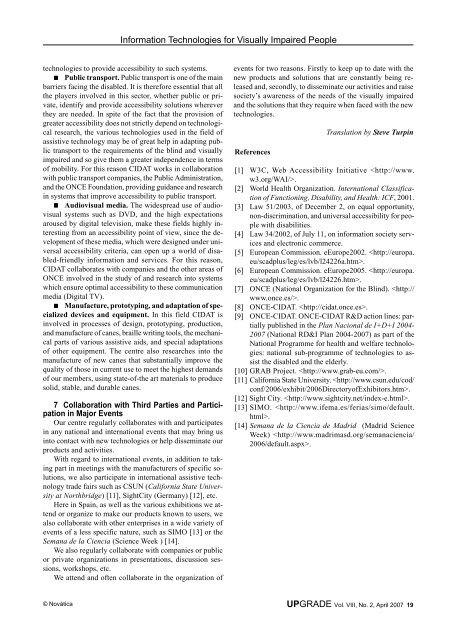Download full issue (PDF 2.1MB) - Council of European ...
Download full issue (PDF 2.1MB) - Council of European ...
Download full issue (PDF 2.1MB) - Council of European ...
Create successful ePaper yourself
Turn your PDF publications into a flip-book with our unique Google optimized e-Paper software.
© Novática<br />
Information Technologies for Visually Impaired People<br />
technologies to provide accessibility to such systems.<br />
Public transport. Public transport is one <strong>of</strong> the main<br />
barriers facing the disabled. It is therefore essential that all<br />
the players involved in this sector, whether public or private,<br />
identify and provide accessibility solutions wherever<br />
they are needed. In spite <strong>of</strong> the fact that the provision <strong>of</strong><br />
greater accessibility does not strictly depend on technological<br />
research, the various technologies used in the field <strong>of</strong><br />
assistive technology may be <strong>of</strong> great help in adapting public<br />
transport to the requirements <strong>of</strong> the blind and visually<br />
impaired and so give them a greater independence in terms<br />
<strong>of</strong> mobility. For this reason CIDAT works in collaboration<br />
with public transport companies, the Public Administration,<br />
and the ONCE Foundation, providing guidance and research<br />
in systems that improve accessibility to public transport.<br />
Audiovisual media. The widespread use <strong>of</strong> audiovisual<br />
systems such as DVD, and the high expectations<br />
aroused by digital television, make these fields highly interesting<br />
from an accessibility point <strong>of</strong> view, since the development<br />
<strong>of</strong> these media, which were designed under universal<br />
accessibility criteria, can open up a world <strong>of</strong> disabled-friendly<br />
information and services. For this reason,<br />
CIDAT collaborates with companies and the other areas <strong>of</strong><br />
ONCE involved in the study <strong>of</strong> and research into systems<br />
which ensure optimal accessibility to these communication<br />
media (Digital TV).<br />
Manufacture, prototyping, and adaptation <strong>of</strong> specialized<br />
devices and equipment. In this field CIDAT is<br />
involved in processes <strong>of</strong> design, prototyping, production,<br />
and manufacture <strong>of</strong> canes, braille writing tools, the mechanical<br />
parts <strong>of</strong> various assistive aids, and special adaptations<br />
<strong>of</strong> other equipment. The centre also researches into the<br />
manufacture <strong>of</strong> new canes that substantially improve the<br />
quality <strong>of</strong> those in current use to meet the highest demands<br />
<strong>of</strong> our members, using state-<strong>of</strong>-the art materials to produce<br />
solid, stable, and durable canes.<br />
7 Collaboration with Third Parties and Participation<br />
in Major Events<br />
Our centre regularly collaborates with and participates<br />
in any national and international events that may bring us<br />
into contact with new technologies or help disseminate our<br />
products and activities.<br />
With regard to international events, in addition to taking<br />
part in meetings with the manufacturers <strong>of</strong> specific solutions,<br />
we also participate in international assistive technology<br />
trade fairs such as CSUN (California State University<br />
at Northbridge) [11], SightCity (Germany) [12], etc.<br />
Here in Spain, as well as the various exhibitions we attend<br />
or organize to make our products known to users, we<br />
also collaborate with other enterprises in a wide variety <strong>of</strong><br />
events <strong>of</strong> a less specific nature, such as SIMO [13] or the<br />
Semana de la Ciencia (Science Week ) [14].<br />
We also regularly collaborate with companies or public<br />
or private organizations in presentations, discussion sessions,<br />
workshops, etc.<br />
We attend and <strong>of</strong>ten collaborate in the organization <strong>of</strong><br />
events for two reasons. Firstly to keep up to date with the<br />
new products and solutions that are constantly being released<br />
and, secondly, to disseminate our activities and raise<br />
society’s awareness <strong>of</strong> the needs <strong>of</strong> the visually impaired<br />
and the solutions that they require when faced with the new<br />
technologies.<br />
References<br />
Translation by Steve Turpin<br />
[1] W3C, Web Accessibility Initiative .<br />
[2] World Health Organization. International Classification<br />
<strong>of</strong> Functioning, Disability, and Health: ICF, 2001.<br />
[3] Law 51/2003, <strong>of</strong> December 2, on equal opportunity,<br />
non-discrimination, and universal accessibility for people<br />
with disabilities.<br />
[4] Law 34/2002, <strong>of</strong> July 11, on information society services<br />
and electronic commerce.<br />
[5] <strong>European</strong> Commission. eEurope2002. .<br />
[6] <strong>European</strong> Commission. eEurope2005. .<br />
[7] ONCE (National Organization for the Blind). .<br />
[8] ONCE-CIDAT. .<br />
[9] ONCE-CIDAT. ONCE-CIDAT R&D action lines: partially<br />
published in the Plan Nacional de I+D+I 2004-<br />
2007 (National RD&I Plan 2004-2007) as part <strong>of</strong> the<br />
National Programme for health and welfare technologies:<br />
national sub-programme <strong>of</strong> technologies to assist<br />
the disabled and the elderly.<br />
[10] GRAB Project. .<br />
[11] California State University. .<br />
[12] Sight City. .<br />
[13] SIMO. .<br />
[14] Semana de la Ciencia de Madrid (Madrid Science<br />
Week) .<br />
UPGRADE Vol. VIII, No. 2, April 2007 19


